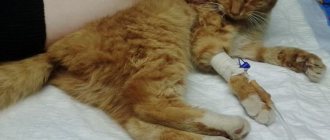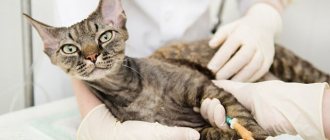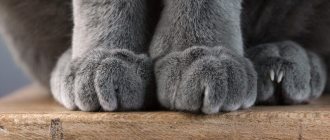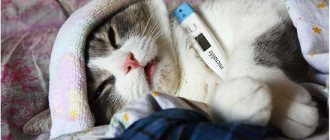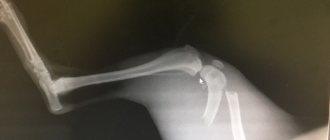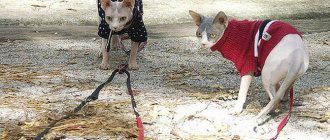A condition such as a broken paw in a cat has several varieties and is accompanied by limb dysfunction, swelling, and pain. Damage is dangerous due to secondary infection, deterioration of the innervation of the limb, and limited mobility. The owner should know the symptoms of injury and be able to provide first aid before taking the pet to the veterinary clinic. The specialist will prescribe treatment, perform surgery and recommend rehabilitation methods.
According to veterinarian statistics, in 55% of cases, broken paws in cats occur due to a fall from a height due to the owner’s oversight.
Why does the fracture occur?
Traumatic injury occurs due to a violation of the integrity of tubular or flat bones. In addition to the paws, fractures of the cat's ribs, bone structures of the pelvis, fingers, and spine are diagnosed. Often injuries are combined. A bruised paw on a kitten can be caused by the owner accidentally stepping on the animal. Causes:
- auto injury;
- landing poorly during a game;
- falling from a window, from a tall tree or roof;
- hitting the paw with a heavy object;
- attack by large dogs;
- lack of calcium in the body;
- osteoporosis;
- metabolic disease.
What are the characteristics of different types of fractures?
Previously, we looked at the actions of cat owners and veterinarians in the event of a “paw fracture” - that is, a fracture of the long tubular bones of the limbs. In a cat, these are the following types of fractures with their symptoms and treatment: hip fractures - that is, the femur, as well as the neck and head of the femur, tibia fractures - the tibia and fibula, humerus fractures - the humerus and forearm fractures - the radius and ulna. . These types of fractures are encountered most often in the practice of a veterinary traumatologist. Let us now move on to the nuances characteristic of other types of fractures.
What types of damage are there?
Most often in animals, it is the radius bone that is damaged.
Among fractures, the most common injury is the radius bone, since the front legs bear the main load during landing. Varieties:
- Injury. It is characterized by compression of the soft tissues of the paw if the cat hits it, but the bone structures remain unharmed.
- Dislocations. The articular head is displaced from the articular capsule. The condition is often combined with a fracture.
- Closed injury. The bone is broken without breaking the integrity of the skin.
- Open fracture. Bone structures break and fragments pierce the skin.
In addition, fractures are of the following types:
- Fragmentation. The bone is crushed into several fragments.
- Multiple. The bone structure is broken in several places.
- Single. The paw is only broken in one place.
Fracture: treatment and care
Closed fractures are treated with conservative methods. After the initial examination and x-rays, the veterinarian fixes the limb with a plaster.
For a speedy recovery, I prescribe for my pet: a regime of maximum limitation of mobility, vitamin supplements, means to strengthen bone tissue, and physical therapy.
Be sure to read:
Vaccinations for cats: what they are needed for, when and which ones are given, table by age, pros and cons
Open fractures require surgery. The veterinarian sets the bone, removes fragments, and fixes the damage with a pin or knitting needle. The animal is prescribed antibiotics and vitamins.
During the rehabilitation period, the owner should limit the pet’s mobility by placing it in a spacious container. After removing the cast, massage the healed paw daily and introduce foods that promote osteosynthesis (bone tissue regeneration) into the diet.
Symptoms: how to tell if a bone is broken?
The injured limb of the animal cannot move fully.
A bruised cat's paw is accompanied by swelling, slight lameness, and pain. After 2-3 days, improvement occurs, and complete recovery occurs within a week. When a limb is dislocated, it looks deformed, hurts, and the animal cannot stand on it. Depending on the location, the signs of a fracture differ as shown in the table:
| Type of injury | Symptoms of a fracture |
| By localization | |
| Damage to the front paw | Severe pain, the animal does not allow you to touch the limb |
| Intensified leg licking | |
| Swelling, puffiness | |
| Limited mobility | |
| Finger fracture | The pad and phalanx become swollen |
| The cat tries not to step on his paw | |
| Compression fracture of the spine | Back deformity |
| Partial or complete paralysis of the limbs | |
| Involuntary urination or bowel movements, constipation | |
| Hip fracture in a cat | Difficulty or lack of movement |
| Hind legs move apart | |
| Unsteady, unsteady gait | |
| Problems going to the toilet | |
| Fracture of a cat's rib or scapula | Unnatural pose |
| Frequent shallow breathing | |
| Abnormal bone mobility | |
| Blood from the mouth if internal organs are hit by bone fragments | |
| By variety | |
| Closed | The integrity of the skin is not compromised |
| Limb deformity | |
| Severe pain, anxiety | |
| The cat drags his sore paw, on which a large hematoma appears | |
| Open | Wound, bleeding |
| Bone fragments visible through damaged skin | |
| Severe pain syndrome | |
| Possible fainting due to pain shock | |
How is the postoperative period going?
As a rule, after osteosynthesis, the cat remains in the hospital for 6 hours to 24 hours under the supervision of doctors. Then, suture treatment and painkillers are usually prescribed for 3-5 days. We recommend restricting movement for 4-6 weeks (cats can be placed in a large cage). The cat usually begins to lean on its paw 3-5 days after surgery.
After 3-4 weeks, you will need to visit the veterinary clinic with your cat again to take a control x-ray to assess the speed of fusion. On average, the rate of fusion, depending on the complexity of the fracture, varies from 2 to 8 months. After fusion, with the exception of rare cases (intra-articular fractures, fractures of the pelvic bones, very complex fractures in which the fixing elements firmly grow into the general mass of callus), metal structures are removed.
What to do if your cat hurts her leg?
If a cat breaks or twists a paw, veterinarians categorically prohibit owners from setting or removing bone fragments on their own.
Before visiting a veterinary clinic, the animal’s limb must be secured with a splint.
If the spine is fractured, the animal should be laid on a hard surface, without placing bolsters under the head or neck. Bags with a soft bottom or carrying a cat in your bosom are not allowed. If the pet's ribs are injured, place them on a hard, non-bending bedding with the broken bones facing up or in a position that is comfortable for the animal. If a cat has a fractured front or hind leg, first aid is provided as follows:
- Provide complete rest to the paw.
- Apply a cold compress for 15 minutes to prevent swelling.
- In case of closed injury, fix the leg with a board or ruler so that the edges of the clamps protrude beyond the injury area:
- If the cat has damaged the shoulder joint, a splint is applied above the shoulder to the shoulder blade;
- The broken hind leg is fixed above or below the hock joint, depending on the location of the fracture line;
- The fingers are secured by applying a tight bandage.
- Place a cotton pad between the clamp and the foot.
- In case of an open fracture, when the skin is torn, particles of dirt should be removed with a sterile cloth, without touching the bone fragments.
- Treat the wound with hydrogen peroxide.
- Dress with a sterile bandage (do not use cotton wool, as the fibers will stick to the wound).
- If the paw is cut off, treat the stump with an antiseptic and apply a bandage.
- Give painkillers - "Ketofen", "Nalbuphine", for painful shock - "Prednisolone".
- Take him to the veterinary clinic immediately.
Injuries in cats
Cats often fall from heights and are injured. Many ordinary people tend to consider a broken limb to be the most “terrible” of such injuries, but in fact, fractures in cats are well treated, and the animal has every chance of making a full recovery. True, fractures are also different. For example, an animal may suffer an intra-articular fracture, in which a crack runs along the surface of the “hinge” of the joint. Such fractures are the most complex, they require long-term treatment and sometimes lead to the development of arthrosis.
Very often, after a fall, the animal begins to drag its hind legs. This may be a sign not so much of paw fractures as of some kind of neurological injury, for example, a fracture of the spinal column. It occurs quite often in cats, and most often occurs at the level of the last thoracic and first lumbar vertebrae. Such a fracture is fraught with serious injury to the spinal cord and, unfortunately, the prognosis in this case is unfavorable.
The animal needs to be shown to a veterinarian as quickly as possible if:
- the cat does not eat or drink;
- limps heavily, does not support a limb;
- The cat developed bloody saliva, bloody discharge from the nose, and blood in the urine.
If the animal feels well, eats and drinks normally, but has a slight limp, then the owner may not rush to visit the doctor. Perhaps the cat just has a sprain or bruise that goes away quickly without treatment. But if lameness does not go away within a few days, then it is better to contact a veterinary clinic.
A rupture of the spinal cord may be indicated by the absence of pain. This is easy to check even at home. You need a suitable tool, such as tweezers, to squeeze the skin between the toes of the hind paw quite firmly. In a normal situation, such manipulation will cause pain - the cat will scream, try to scratch or bite. In this case, the prognosis will be favorable. But if the animal does not react in any way to such pain, then, most likely, its spinal cord is seriously injured. Even if the cat jerks its paw when squeezed, this does not mean anything. This is how the flexion reflex manifests itself, which can persist even with a complete rupture of the spinal cord. In case of spinal injury, only the feeling of pain can be considered a favorable factor that gives the animal a chance to recover.
Often, injuries associated with a fall from a great height lead to rupture of the diaphragm (the so-called partition between the chest and abdominal cavities). When it ruptures, part of the internal organs of the abdominal cavity, in particular the intestines and liver, can move into the chest cavity, where the lungs are located. Externally, such damage is expressed in the fact that the animal develops rapid breathing and cyanosis of the mucous membranes, because the lungs can no longer fully expand. The cat loses its appetite, and due to the pain caused by the injury, stiffness appears in its movements. But an accurate diagnosis can only be made using radiographic examination. If the diaphragm ruptures, the animal requires surgery, which can only be performed in a veterinary clinic.
Treatment: how to act correctly?
Traditional methods
Using X-rays, the animal can be diagnosed quickly.
An x-ray can help determine the extent of injury. If the fracture is minor, the fixing splints are removed and a splint is put on. Plaster is not used in cats because it is ineffective and causes improper fusion of bone structures and poor circulation. Unlike a plaster cast, the splint is lightweight and holds the paw well. The leg heals in about 20 days; in difficult cases, the fixator can be removed after 1.5 months. If necessary, a control x-ray should be taken.
When is surgery necessary?
If a cat breaks its paw, it needs to be treated with surgery. The procedure of intramedullary osteosynthesis is performed - internal fixation of bone fragments with knitting needles and pins. For hip fractures, the method of bone osteosynthesis using orthopedic bolts is used. For comminuted fractures, combined methods are used. If a cat has injured and broken its paw, or areas of gangrene or necrosis have appeared, amputation, when the affected part has to be cut off, can cure the pathology.
First aid for a fracture
What to do in this case? First, carefully move the animal to a comfortable place, such as a crate or box, cover it with a blanket and take it to the veterinarian. If there is still a fracture, the specialist will apply a special splint to the paw. Of course, it can be done at home, but, you know, the matter is too delicate and requires a professional approach, because a cat, feeling pain, can use its claws and teeth. If there is a suspicion of damage to the bones of the spine or skull, do not move the animal under any circumstances. Cover him with a blanket and call the vet.
In kittens and young cats, fractures heal quickly, and, as a rule, without consequences
After the examination, the mustache must be taken for an x-ray in order to see in which anatomical area the damage occurred, to find out its nature (open, closed, oblique, crushed, transverse) and whether there are any other defects.
What are the consequences?
After a fracture, complications may occur, such as:
Tetanus bacillus can be introduced into an animal's wound when it receives an open type of injury.
- Muscular atrophy. Occurs in combination with spinal injury, when the neurons of the spinal cord are affected. The hind legs hardly function, and the cat drags them, sensitivity decreases.
- Secondary infection. Open injuries are dangerous because staphylococcus, Pseudomonas aeruginosa, and tetanus bacteria enter the wound, which can be fatal.
- Arthrosis. The cartilage is destroyed and the legs look crooked, they hurt, and the cat cannot position them normally when moving.
Limb amputation
A unique cat who lives a full life with only two!
front paws! If the fracture is very complex and does not heal in any way, and, moreover, an acute purulent process begins at the site of the injury, then the veterinarian may recommend amputation of the limb.
I will say right away that you do not need to choose between amputation and euthanasia of an animal. Cats easily adapt to life on three legs. They are no different from other cats: they are just as agile and dexterous.
Amputation is a way to prolong the life of an animal and the possibility of its recovery. And for you – a plus for many, many more years of communication with your pet.
If you find an error, please select a piece of text and press Ctrl+Enter.
How to recognize a fracture or bruise of a hind paw
Examination of the hind paw.
The wound may be between the joints or on the inner surface of the pad, between the cat's toes. It happens that during a jump the animal pushes off the surface incorrectly. In this case, joint dislocation and ligament sprain are almost always guaranteed. Cats who are obese and lead a sedentary lifestyle are most susceptible to such damage.
Fracture of the hind leg of a cat on ultrasound.
The joints of such animals are poorly developed and with a strong push or sudden movement the risk of injury increases. A dislocation, sprain, or bruise may have slight swelling and be quite painful when pressed.
What to do if your cat is limping on its hind leg without visible damage
Severe swelling of the paw.
Upon closer examination, swelling becomes visible, the paw is hot and painful. A significant reason is pathology in the formation of the joint. When the kitten is still small, the symptom of lameness is rarely observed. The baby's weight is insignificant, which means the load on the paws is also small. As people get older, lameness becomes more noticeable.
Lameness in a cat
Another reason for lameness in a cat is due to diseases such as arthritis or arthrosis. Arthritis appears as the animal gets older. The influence on the body of external factors that provoke infectious diseases worsens with age, which makes it possible for inflammatory processes in the joints to manifest themselves.
The older the cat, the greater the likelihood of exacerbations of the disease, which is accompanied by periodic pain and, as a result, lameness.
Arthrosis
The cat is limping on its hind leg due to arthrosis.
It can proceed hidden for a long time, since degenerative changes in tissues, bones and cartilage occur gradually. There are many reasons, the most common is a congenital anomaly of the anatomical structure.
As with arthritis, adult felines are most susceptible, but there are exceptions when the congenital changes are too extensive. Then lameness is observed in young animals.
Traumatic arthrosis
Complex case.
Arthrosis can be traumatic. The cat was injured while walking; there were no obvious symptoms; over time, the bruised tissues, bones, and cartilages begin to rebuild incorrectly. Do not discount lumbar back injuries.
The pet could have been hit during a walk, or it could have landed poorly during a fight with other animals, dogs, for example. With a traumatic injury to the back, nerve endings may be pinched, which causes discomfort when walking.
Causes
If a cat lives in the house, you need to take into account the characteristics of its character. Some of them pose a potential threat to the health of the animal. The animals are extremely curious, and they also have a very strong hunting instinct.
A cat can forget about everything in the world if it is chasing a bird or a fly. If she is sitting on the edge of the windowsill at this time, the matter may end in injury.
The most common causes of paw fractures in cats are:
- jumping from heights;
- injuries on the highway;
- accidental injuries (for example, being caught in a door);
- development of osteoporosis, rickets or osteomalacia;
- blows that were inflicted by people or animals;
- congenital fragility of the musculoskeletal system - as a rule, this feature is found in purebred animals;
- exposure to external factors that weaken the immune system and reduce bone density;
- osteosarcoma;
- infectious lesions.
According to statistics, paw fractures are most common among felines. The pelvis, tail or spine are much less likely to be injured.
